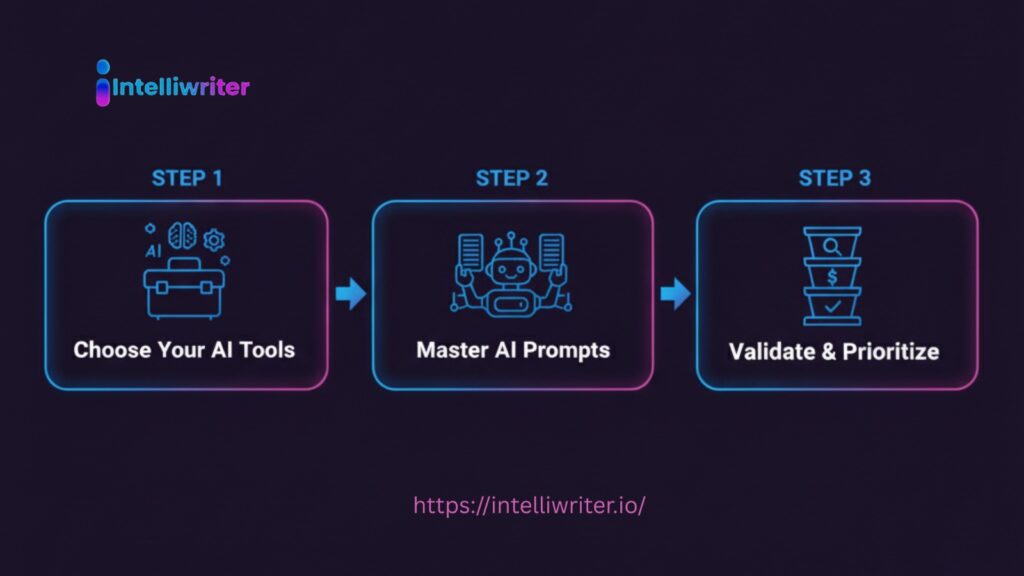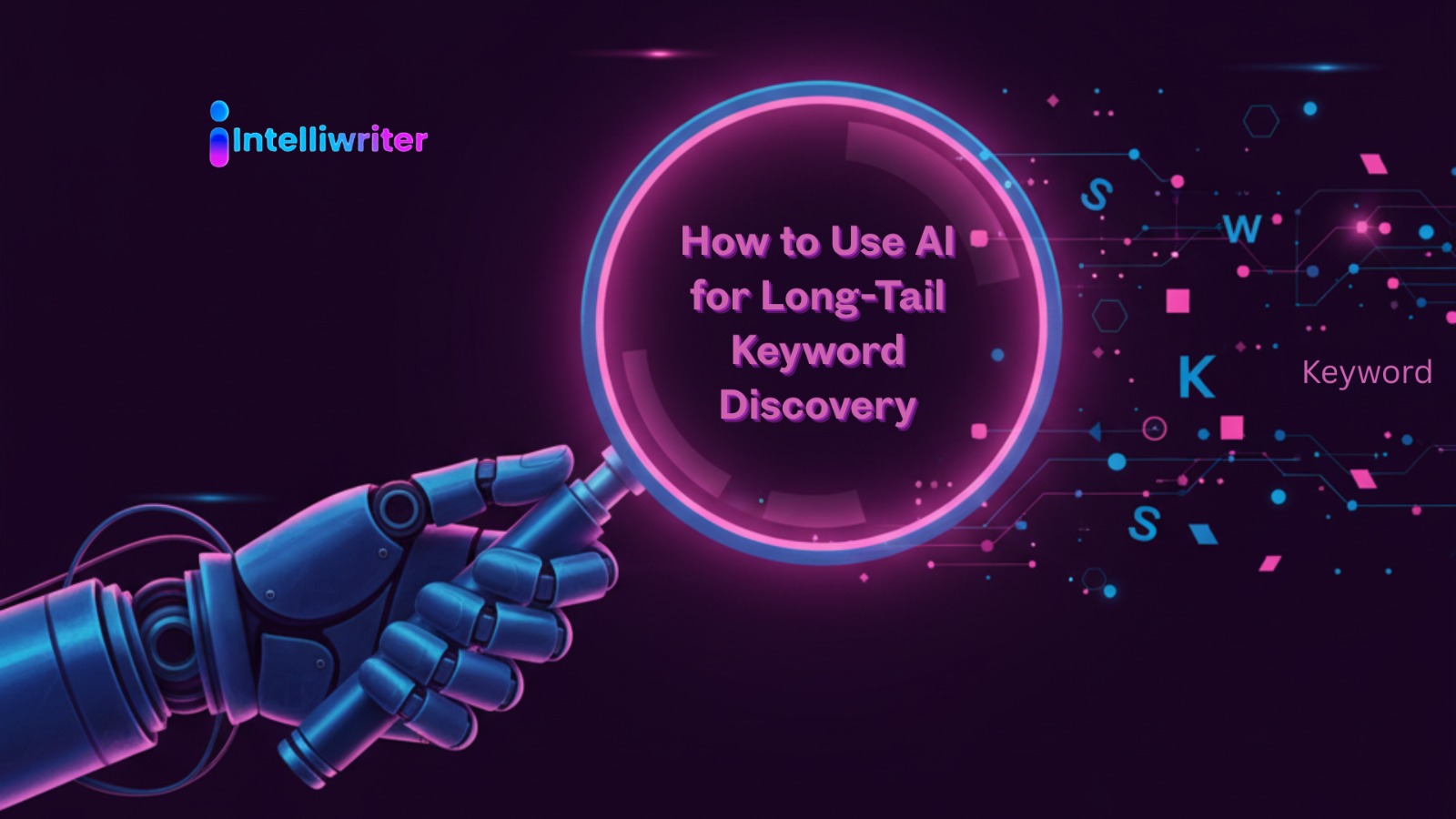I remember sitting with a client last year who was spending $15,000 monthly on PPC but could not crack organic search. “We have tried everything,” they told me, frustration evident in their voice. Then we implemented the exact AI for long-tail keyword discovery framework I’m about to share with you. Within 90 days, their organic conversions increased by 237%, without additional ad spend.
This is not just another theoretical guide. This is the same proven method that we use at https://intelliwriter.io/ to help clients find hidden keyword options that really help their businesses.
Why Traditional Keyword Research Is Broken (And How AI Fixes It)
Remember when you would stare at Google Keyword Planner and try to figure out what those monthly search numbers meant? I spent years making content plans with incomplete information, only to see my rivals rank for keywords I had never even thought of.
The issue with standard ways is what I call “surface scraping”: you can only see the same keywords that everyone else can see. When people are ready to buy, AI-powered long-tail discovery digs deeper to find the exact words people use.
The Hidden Cost of Missing Long-Tail Opportunities
I viewed an e-commerce client who was only using head terms just last month. We found the following when we put their product categories through our AI keyword research system:
- 142 terms that were question-based, which they weren’t focusing on.
- 67 comparison terms with clear commercial intent
- 23 variations of “near me” that could be used for area searches
The most shocking finding? Their competitors weren’t targeting these either. The landscape was wide open.
The Complete AI Long-Tail Keyword Discovery Framework

Step 1: Choose Your AI Keyword Research Tools
AI for keyword discovery doesn’t have to cost a lot of money to get started. These are the tools I think you should use:
Free Options:
- ChatGPT to start coming up with ideas
- Search Bard for up-to-date trends
- intelliwriter.io to write content that is SEO-friendly
Paid Professional Tools:
- The AI Keyword Magic Tool from SEMrush
- Keywords Explorer from Ahrefs
- Frase to optimize the content
I usually tell people to start with Intelliwriter.io because it blends AI keyword research with real content creation, so you don’t have to switch between platforms.
Step 2: Master the Art of AI Keyword Research Prompts
Which prompting technique you use has a direct effect on the quality of your AI long-tail discovery results. After trying hundreds of different versions, these are the ones that worked best for me:
For Topic Exploration:
text
Act as an SEO expert with 15 years of experience. Generate a complete long-tail keyword map for [your topic], including:
- Question-based keywords (how, what, why)
- Commercial intent keywords (best, review, compared)
- Location-specific variations
- Problem/solution keywords
Include search intent analysis for each cluster.”
For Competitor Gap Analysis:
text
“Analyze the top 5 ranking pages for [keyword] and identify long-tail opportunities they’re missing. Focus on:
- Semantic gaps in their content
- Unanswered questions in their FAQs
- Related topics, they barely mention
Provide specific keyword recommendations with estimated commercial value.”
Step 3: Validate and Prioritize Your AI-Generated Keywords
This is the part of AI keyword research where most people fail. They get a lot of ideas, but they don’t have a way to tell the good ones from the bad ones.
After spending months on the wrong keywords, I made this simple validation framework:
The 4-Layer Validation Filter:
1. Search Volume & Difficulty
- Minimum: 10 monthly searches
- Maximum: 300 searches (for true long-tails)
- Difficulty: Under 30 if possible
2. Commercial Intent Score
- High: Buying keywords (“price,” “buy,” “deal”)
- Medium: Research keywords (“best,” “vs,” “review”)
- Low: Informational (“how to,” “what is”)
3. Content Gap Analysis
- Are competitors covering this well?
- Is there room for better content?
- Can we provide unique value?
4. Business Alignment
- Does this keyword match our offerings?
- What’s the estimated conversion value?
- How difficult would content creation be?
Advanced AI Long-Tail Keyword Strategies
Semantic Search and User Intent
Google’s latest AI overview updates mean that understanding semantic relationships is more important than ever. When you use AI for long-tail keyword discovery, you’re not just finding individual keywords; you’re mapping entire topic clusters.
Example Semantic Cluster for “Content Marketing”:
| Core Topic | Related Entities | Long-Tail Variations |
| Content strategy | Planning, calendar, ROI | “content calendar template B2B” |
| Content creation | Writing, video, design | “How to write viral LinkedIn posts” |
| Content distribution | Social media, email, SEO | “best times to post on Instagram 2025” |
The Voice Search Revolution
As the number of voice assistants grows, long-tail keywords for voice search are becoming more important. Most of the time, voice searches are 3–5 words longer than text searches and use normal language patterns.
Voice Search Optimization Plan:
- Use question-based keywords
- Write in natural language
- Make your site work best for “near me” searches;
- Focus on conversational terms.
Voice Search Optimization Strategy:
- Target question-based keywords
- Use natural language in content
- Optimize for local “near me” searches
- Focus on conversational phrases
Real-World Case Study: From 0 to 5,000 Monthly Visitors
We had a client in the exercise niche at Intelliwriter.io who was having a hard time ranking for competitive terms like “home workouts.” When we used our AI long-tail discovery strategy, we found gold in places we didn’t expect:
Before AI Discovery:
- Primary focus: “home workouts” (Difficulty: 85)
- Monthly organic traffic: 800 visitors
- Conversion rate: 1.2%
After AI Discovery:
- New focus: “low-impact home workouts for seniors with arthritis”
- Monthly organic traffic: 5,200 visitors
- Conversion rate: 4.7%
The client now has a lot of authority over several long-tail versions that bring them more targeted traffic than their main keyword ever did.
Common AI Keyword Discovery Mistakes to Avoid

Mistake #1: Trusting AI Outputs Without Validation
In the beginning of my AI journey, I came up with 500 “long-tail keywords” for a client, but 30% of them had no search traffic. Always use standard tools to check.
Mistake #2: Ignoring Search Intent
After ranking #1 for “free project management software,” but zero conversions. Why? It costs $29 a month to use our service. The goal was completely wrong for our company.
Mistake #3: Over-Optimizing for Volume
The sweet spot for long-tail keywords is typically 50-300 monthly searches. Higher volumes often mean more competition and less specific intent.
Frequently Asked Questions
How accurate is AI for keyword research?
Modern AI tools are fairly good at coming up with keyword ideas, but they should always be used with traditional tools to make sure the ideas are correct. With the right prompts and checks, Intelliwriter.io gets about 85% of the time.
What’s the best AI tool for long-tail keyword discovery?
While ChatGPT is popular for beginners, we built Intelliwriter.io specifically for SEO professionals who need integrated keyword discovery and content creation in one platform.
How often should I update my long-tail keyword strategy?
We recommend quarterly reviews with monthly monitoring. Search behavior evolves constantly, and AI tools can help you stay ahead of emerging trends.
Can AI replace traditional keyword research tools?
No, not really. AI is great at coming up with ideas and spotting patterns, but you still need standard tools to look at large amounts of data and analyse your competitors. The two together are strong.
Start Your AI Long-Tail Discovery Journey Today
SEO is changing faster than ever, but one thing remains the same: companies that communicate with their customers in their own language win. When you use AI to find long-tail keywords, you don’t just find new terms; you also find out more about your customers.
I’ve seen this framework change companies many times. By focusing on long-tail keywords that their rivals overlooked, one B2B client transitioned from struggling to fill their pipeline to consistently generating 47 qualified leads every month solely through organic search.
Are you ready to use these strategies? https://intelliwriter.io/ helps you use everything you’ve learnt in this guide by combining AI-powered keyword research with smooth content writing.
What hidden keyword opportunities will you uncover today?

Leave a Reply